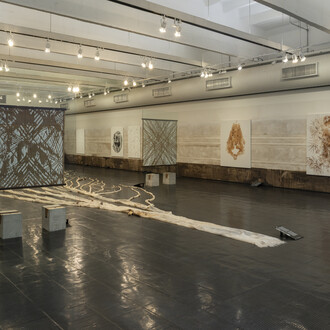It is in the memory of the instant that time is suspended, in the gestural contour we experience ancestral narratives and lessons that run through the layers and textures of Californian Dashiell Manley and Venezuelan Samuel Sarmiento. The exhibition Instant-memory consolidates the poetic crossing between practices that project a rhythmic dialog into space in lilac tones that blend together, amalgamating different techniques and material processes. A certain synesthesia flows, through the construction of images we are provoked in other senses, capturing the sound of colors and the sensitivity of textures, the enameled pigment intertwines with the moldable aspect of the paint paste on the canvas.
The sculptural gesture is formative in both artists. Sarmiento recounts narratives in paintings on ceramic support; and Manley sculpts light with oil paint in thick, three-dimensional paintings, projecting refractions in various colors and subtly different angles, to finally reflect on the observer. Manley's formations border on the abstract, but other possible forms emerge, such as distant atmospheres to be discovered, the rustle of foliage in an autumn landscape or even frames of the wind drawing over salty water. These perceptions arise from his pictorial modeling, a relief that forms and multiplies from the condensation of dense paint. Starting from white, he projects topographies in tonal cadences, outlining a chromatic choreography.
Manley's gesture is characterized by deeply focused and repetitive techniques and processes, employing incessant gestures when depositing paint - the veils of color overlay silent traces of gesture and matter in a visual reflection akin to ikebanas, which erupt floral formations, branches and leaves. His techniques interweave East Asian mindfulness traditions with emotional responses to events and socio-political themes. Meticulous compositions connect the meditative process of the artist and the observers, who become inebriated by the energy emanating from the painting.
Historical research is a path to reinterpreting the setbacks inherent in human survival, as well as identifying the transatlantic exchanges and connections that have bound humanity at different levels. Sarmiento, through drawing, recovers narratives that encompass Caribbean founding knowledge and learning mechanisms based on orality. Each object is allegorical, relating to historical processes such as extractivism, identity construction and migration. The ceramics unite expression and narrative, a maintenance of a resolute heritage from a contemporary perspective, translating the pictorial operation from painting to the sculptural object.
Ancestral myths and tales have spanned hundreds of thousands of years to offer a glimpse into the origin of the universe, the earth and humanity. Sarmiento translates orality into figuration, builds on ancestral knowledge in art and enunciates Caribbean cosmogony in all its nuances, violence, subtlety, enchantment and ancestral repertoire. He revisits one of these tales, in which men lived in a perpetual dance with thirst. Water, a fundamental and sacred elixir, was impossible to imprison. The wise-eyed elders of the stars invoked the goddess of the jungle, who revealed to them the secret of the river's profundity and, when they plunged into its depths, they found stones and clay, endowed with magic, as it turned into resistance when touched by fire, capable of containing water and food - pottery had been created, allowing men to master thirst and hunger. In the interim, the river, very jealous of its secrets, also led to the awakening of human greed and ambition. Once a source of life, it became a battlefield. The fate of humanity resonates in the echoes of the rivers, in the scars of the soil.
Each ceramic retraces these narrative universes, crystallizing orality in contemporary times. The sculptures re-tell the story of the conquered, questioning aesthetic extractivism and adding symbolic layers, reviving and re-signifying what was purposely buried.
Despite their different backgrounds and referential fortunes, the artists create a profound conceptual and formal dialog. The kind of production focused on matter is a catalyzing component of the duo's poetic production, which manipulates the material and each trace of pigment becomes part of the visual discourse. The spiked edges that frame the ceramics are contaminated and complemented by the spatulate layers of crepuscular oil paint. The cerulean combines with the golds, the ethereal lilacs emerge from the amber yellows, an oscillation between figuration and abstraction.
Manley and Sarmiento appropriate the material and the expansion of the support, each in their own way, with the fragility and strength of the action of the gesture being synchronous, the weaving between the textures of the oil and the ceramic glaze. We glimpse in Sarmiento's golden faces the memory of when life dominated by darkness was broken by the action of the sea goddess who threw rocks and coral towards the sky. Bright openings appeared and the stars were revealed. This splendor left its mark on human eyes, the pupils, which allow us to contemplate celestial bodies and planets, and appreciate the intense luminosity that emanates from Manley's pictorial formations.
The capture of the instant is always paradoxical, it is presence and absence, something not very concrete, yet absolutely tangible, and its forcefulness is prolonged in the encounter with their poetics. It is in the texture of the vitreous shine that the ceramics preserve information for future generations, just as it is the knowledge that lies in each of the imbricated cavities of the oil paint. When we come across the pieces, we contemplate time, sometimes fleeting or lengthy, the enveloping synaesthesia as in the second of the condensation of dew, we walk through its nuances. It is in the repeated marks of history that the meditative process emerges in the instant of memory, of the elongation of time and its fissures, relieving the weight of memory through the elevation of form.
(Text by Mariane Beline)








